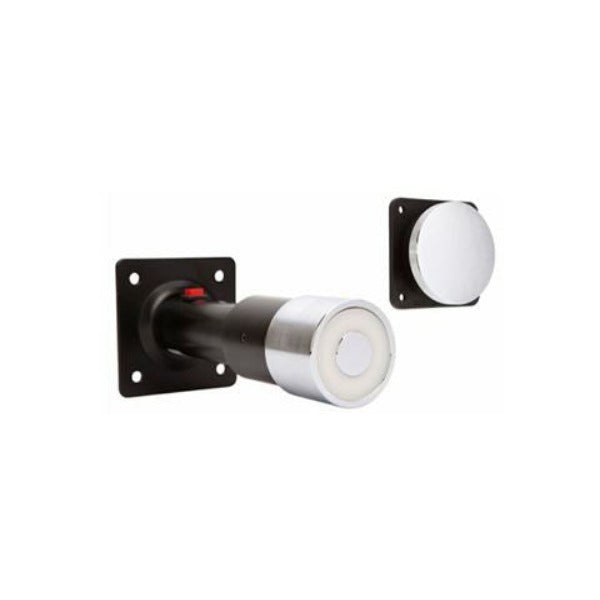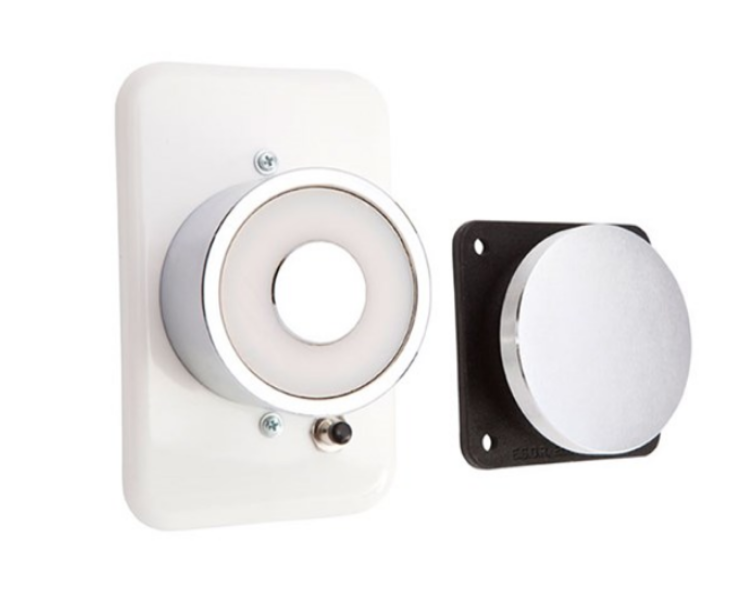A magnetic door holder is a device used to keep a door open in a specific position. It works by utilising the magnetic force between two magnets to hold the door in place.
Magnetic door holders are often used in commercial and residential settings, such as offices, homes, and public buildings.
Recently viewed
Magnetic door locks work by using a magnet to hold the door closed. The magnet is typically located on the door frame, and the metal armature is located on the door. When the door is closed, the magnet and armature come together and create a strong magnetic force that holds the door in place.
- Non-monitored magnetic door locks are not connected to a central security system. This means that they cannot generate an alarm if the door is opened without authorization.
- Non-monitored magnetic door locks are less secure than monitored door locks, but they are also less expensive.
Magnetic door locks are very difficult to pick or force open, making them a good choice for securing valuable assets. However, it is important to note that no lock is completely foolproof, and a determined thief may still be able to break into a door that is secured with a magnetic lock.
- Surface-mounted door strikes: These strikes are mounted on the surface of the door frame and are suitable for retrofitting existing doors.
- Mortise door strikes: Mortise door strikes are recessed into the door frame, providing a clean and concealed appearance.
- Adjustable door strikes: Adjustable door strikes allow for precise alignment and adjustment of the strike to ensure proper operation.
- Bolt-type door strikes: Bolt-type door strikes feature a bolt that extends and retracts to engage or disengage the door.
- Magnetic door strikes: Magnetic door strikes utilize magnets to hold the door securely closed.
- Remote Control: Electric door strikes can be remotely operated using keypads, access cards, or mobile devices, allowing for seamless entry and exit without the need for physical keys.
- Increased Security: Unlike traditional mechanical locks, electric door strikes are more resistant to forced entry, making them ideal for high-security applications.
- Fail-Safe or Fail-Secure Operation: Electric door strikes can be configured to operate in either fail-safe or fail-secure mode. In fail-safe mode, the strike releases when power is lost, allowing for emergency egress. In fail-secure mode, the strike remains locked without power, providing additional security.
- Compatibility with Access Control Systems: Electric door strikes are compatible with various access control systems, including keypads, card readers, and biometric devices. This integration allows for centralized control and monitoring of access rights.
- Easy Installation: Electric door strikes are relatively easy to install and require minimal modifications to existing door frames.
- Durability: Electric door strikes are constructed from sturdy materials and are designed to withstand daily use and harsh environmental conditions.
- ADA Compliance: Electric door strikes can be equipped with accessible features, such as automatic door openers, to comply with the Americans with Disabilities Act (ADA) requirements.
- Fire Safety: Electric door strikes can be integrated with fire alarm systems to automatically release in the event of a fire, ensuring safe and efficient evacuation.
- Commercial buildings: Office buildings, retail stores, and other commercial establishments use electric door strikes to control access to restricted areas and enhance overall security.
- Residential buildings: Apartments, condos, and private residences can benefit from electric door strikes for added security and convenient keyless entry.
- Industrial facilities: Warehouses, factories, and other industrial facilities often utilize electric door strikes to secure sensitive areas and control access to hazardous materials.
- Healthcare facilities: Hospitals, clinics, and other healthcare facilities rely on electric door strikes to ensure patient safety and privacy.
- Educational institutions: Schools, universities, and other educational institutions use electric door strikes to control access to classrooms, laboratories, and other restricted areas.




















